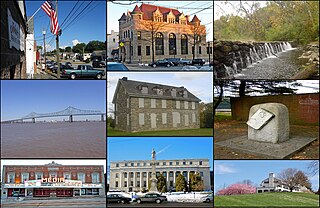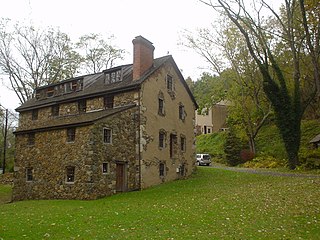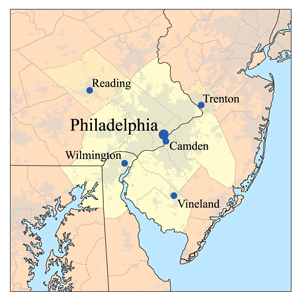
Pennsylvania, officially the Commonwealth of Pennsylvania, is a state located in the northeastern, Great Lakes and Mid-Atlantic regions of the United States. The Appalachian Mountains run through its middle. The Commonwealth is bordered by Delaware to the southeast, Maryland to the south, West Virginia to the southwest, Ohio to the west, Lake Erie and the Canadian province of Ontario to the northwest, New York to the north, and New Jersey to the east.

The University of Pennsylvania is a private Ivy League research university in Philadelphia, Pennsylvania. It is one of the nine colonial colleges founded prior to the Declaration of Independence and the first institution of higher learning in the United States to refer to itself as a university. Benjamin Franklin, Penn's founder and first president, advocated an educational program that trained leaders in commerce, government, and public service, similar to a modern liberal arts curriculum.

Philadelphia, known colloquially as Philly, is the largest city in the U.S. state and Commonwealth of Pennsylvania, and the sixth-most populous U.S. city, with a 2018 census-estimated population of 1,584,138. Since 1854, the city has been coterminous with Philadelphia County, the most populous county in Pennsylvania and the urban core of the eighth-largest U.S. metropolitan statistical area, with over 6 million residents as of 2017. Philadelphia is also the economic and cultural anchor of the greater Delaware Valley, located along the lower Delaware and Schuylkill Rivers, within the Northeast megalopolis. The Delaware Valley's population of 7.2 million ranks it as the eighth-largest combined statistical area in the United States.

Delaware County, colloquially referred to as Delco, is a county located in the U.S. state of Pennsylvania. With a population of 562,960, it is the fifth most populous county in Pennsylvania, and the third smallest in area. The county was created on September 26, 1789, from part of Chester County, and named for the Delaware River.

Thornbury Township is a township in Delaware County, Pennsylvania, United States. The population was 8,028 at the 2010 census, up from 7,093 at the 2000 census. It is adjacent to, and was once joined with, Thornbury Township, Chester County, Pennsylvania. It contains part of the census designated place of Cheyney University.

The Delaware Valley is the valley through which the Delaware River flows. By extension, this toponym is commonly used to refer to Greater Philadelphia or Philadelphia metropolitan area, which straddles the Lower Delaware River just north of its estuary. The Delaware Valley Metropolitan Area is located at the southern part of the Northeast megalopolis and as such, the Delaware Valley can be described as either a metropolitan statistical area (MSA), or as a broader combined statistical area (CSA). The Delaware Valley Metropolitan Area is composed of several counties in southeastern Pennsylvania and southwestern New Jersey, one county in northern Delaware, and one county in northeastern Maryland. The MSA has a population of over 6 million, while the CSA has a population of over 7.1 million. Philadelphia, being the region's major commercial, cultural, and industrial center, wields a rather large sphere of influence that affects the counties that immediately surround it.

The Province of Pennsylvania, also known as the Pennsylvania Colony, was founded in English North America by William Penn on March 4, 1681 as dictated in a royal charter granted by King Charles II. The name Pennsylvania, which translates roughly as "Penn's Woods", was created by combining the Penn surname with the Latin word sylvania, meaning "forest land". The Province of Pennsylvania was one of the two major Restoration colonies, the other being the Province of Carolina. The proprietary colony's charter remained in the hands of the Penn family until the American Revolution, when the Commonwealth of Pennsylvania was created and became one of the original thirteen states. "The lower counties on Delaware", a separate colony within the province, would breakaway during the American Revolution as "the Delaware State" and also be one of the original thirteen states.
Swatara Creek is a 72-mile-long (116 km) tributary of the Susquehanna River in east central Pennsylvania in the United States. It rises in the Appalachian Mountains in central Schuylkill County and passes through northwest Lebanon Valley before draining into the Susquehanna at Middletown.

The History of Pennsylvania begins in 1681 when William Penn received a royal deed from King Charles II of England, although human activity in the region precedes that date. The area was home to the Lenape, Susquehannock, Iroquois, Erie, Shawnee, Arandiqiouia, and other American Indian tribes. Most of these tribes were driven off or reduced to remnants as a result of diseases, such as smallpox, that swept through long before any permanent colonists arrived.

Penn's Landing is a waterfront area of Center City Philadelphia along the Delaware River. Its name commemorates the landing of William Penn, the founder of Pennsylvania in 1682. The actual landing site is further south in Chester, Pennsylvania. The city of Philadelphia purchased the right to use the name. Penn's Landing is bounded by Front Street to the west, the Delaware River to the east, Spring Garden Street to the north, and Washington Avenue to the south, and is primarily focused on the Christopher Columbus Boulevard corridor.

Torresdale, also formerly known as Torrisdale, is a neighborhood in the Far Northeast section of Philadelphia. Torresdale is located along the Delaware River between Holmesburg and Bensalem Township in neighboring Bucks County.

The Swann Memorial Fountain is an art deco fountain sculpture located in the center of Logan Circle in Philadelphia, Pennsylvania, United States.
Chi Upsilon Sigma (ΧΥΣ) — official name is Corazones Unidos Siempre Chi Upsilon Sigma National Latin Sorority, Inc. — is a Latina oriented Greek letter intercollegiate sorority. Chi Upsilon Sigma was founded on April 29, 1980, by seven Latinas at the New Brunswick Campus of Rutgers University in New Brunswick, New Jersey.

William Penn State Forest is a Pennsylvania State Forest in Pennsylvania Bureau of Forestry District #17. The main offices are located in Elverson in Chester County, Pennsylvania in the United States.

Market Street, originally known as High Street, is a major east–west street in Philadelphia, Pennsylvania. It is signed as Pennsylvania Route 3 between 38th Street and 15th Street. A short portion of the road continues west from Cobbs Creek Parkway to Delaware County.
William Penn is a name given to a number of schools and educational establishments, including:




















